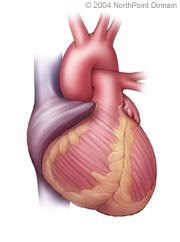Nuclear Stress Testing
Basic Facts
- A nuclear stress test, also referred to as a myocardial perfusion scan, is one of the most commonly performed diagnostic heart tests.
- During a nuclear stress test, a small amount of a radioactive isotope is injected into a person's bloodstream.
- The distribution of the radioactive isotope in the heart muscle is recorded by a camera shortly after the person exercises. The camera produces three-dimensional images of the heart that show the physician exactly where the heart muscle may not be receiving enough blood and oxygen.

Coronary heart disease, or CHD, is the accumulation of plaque in a coronary artery sufficient to obstruct blood flow. One way that a physician diagnoses CHD is through a nuclear stress test. During a nuclear stress test, a small dose of a radioactive isotope is injected into the bloodstream. The radioisotope, or tracer, is carried through the bloodstream and into the myocardium, or heart muscle. Shortly after exercising, a special camera senses the radioactivity of the tracer and constructs an image of the heart. Parts of the heart muscle that receive normal blood flow receive larger amounts of tracer and appear brighter than areas that have inadequate blood flow.
The results of a nuclear stress test typically fall into three broad categories.
- Normal;
- Blood flow defects during exercise, but not at rest; and
- Blood flow defects during exercise and rest.
PRE-TEST GUIDELINES
People are instructed to avoid eating and drinking after midnight the night before the test and discontinue certain medications. People should wear comfortable clothing in which to exercise. Pregnant women should check with their physician before engaging in a nuclear stress test.
WHAT TO EXPECT
In the testing room, a nurse or technician will start an intravenous line, or IV, in the arm of the person being tested and will place approximately 10 small, sticky ECG electrodes with wires attached to them on the person's chest and back.
Recordings of the heart's resting activity are made before exercise begins. The patient begins the stress test by walking slowly on a treadmill. The speed and incline of the treadmill typically increase every 3 minutes to raise the patient's exertion level and increase the work the heart must do. Exercise typically lasts from 5 to 15 minutes.
When the person's maximum predicted heart rate has nearly been reached, the radioactive tracer is injected through the IV. The person continues exercising for about 1 minute to allow the tracer to disperse through the heart. The person is then asked to stop exercising and lie still on a table underneath a camera that rotates and senses the radiation being emitted by the tracer. The camera may record images for 30 to 45 minutes.
The person then relaxes for 3 or 4 hours, after which a second set of images are recorded.
For people who cannot exercise, the effects of exercise can be simulated with drugs, such as dobutamine and regadenoson.
The entire nuclear stress test may take between 2 and 6 hours.
POST-TEST GUIDELINES
Patients are encouraged to drink plenty of fluids to flush the radioactive tracer. They can resume normal activities immediately following the test.
Copyright © 2017 NorthPoint Domain, Inc. All rights reserved.
This material cannot be reproduced in digital or printed form without the express consent of NorthPoint Domain, Inc. Unauthorized copying or distribution of NorthPoint Domain's Content is an infringement of the copyright holder's rights.
